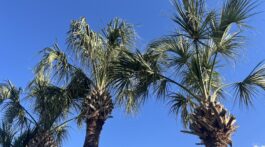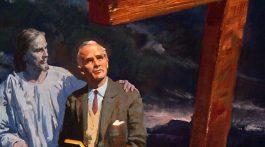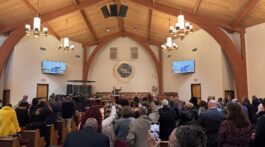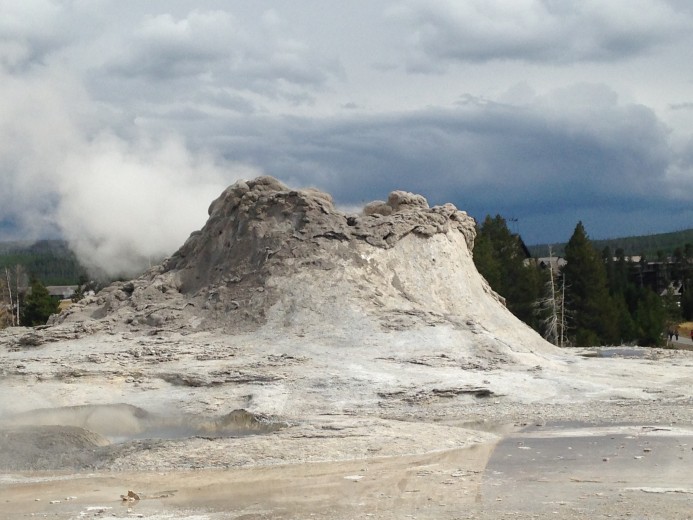It took me 28 years to make it to Yellowstone National Park
Actually, my husband took us on our first family vacation because it’s the only thing I wanted for my birthday. So, the day after my birthday, there we were, sitting on the board walk amid three hundred other people waiting for Old Faithful to erupt. Old Faithful is so named because no other geyser in earth’s history has kept a schedule like she has for as long as she has. We cannot predict another’s eruption like we can for Old Faithful. She doesn’t shoot the highest stream of water and steam. When she’s not erupting she’s just a mound of gray dirt that spews out steam.
Yet there we were, for twenty minutes, babies crying all around us (including mine), waiting. Then, just 7 minutes after the estimated time, she began spitting water high into the air, then steam, and then a stream of hot water shot into the air as if someone opened a faucet beneath the earth. Ten seconds, thirty seconds, nearly two minutes and it’s finished shooting water and just like that, the only remnants of the eruption are streams of water flowing in all directions. People turn to leave, and she sits alone for another 90 minutes until her next predicted eruption.
We saw Old Faithful erupt twice
After we saw Old Faithful erupt once my husband said “That wasn’t that impressive”, and it was just by coincidence that I got to see it a second time before we left–because he wouldn’t have waited again to see it. That was our first day at Yellowstone. Every single day we were there we saw steam coming up from the ground. We saw geysers of mud brown, blue, orange, green. We saw mountains so young in relation to others in our country, they’re even still growing. Then one day we took a mini-cruise across Yellowstone Lake, during which the tour guide said that the world’s largest super volcano was beneath us. Then my husband leaned over and said, “umm…I didn’t know that.”
It’s all we could think about
After the Ranger said that we were on top of the world’s largest super volcano, it’s all we could think about. The steam rising from the dirt, the mountains around us still growing, even the types of foliage growing and where were all because of the volcano beneath. As we hiked through the forests and up into the mountains looking for wildlife and talking to the kids about God’s creation, I couldn’t help but compare this world with the one God created. We think and talk a lot about God’s creation compared to today–the perfection of then, the sin of now. What we sometimes don’t think about is how the earth was affected.
While we were at Yellowstone we drove a lot, and I wanted to stop and walk through every geyser basin there was. We were walking next to one extremely beautiful geyser called the Grand Prismatic Spring and I mentioned it would be awesome to swim in one when I get to heaven. Morrel looked at me and said, “this won’t be in heaven. It’s caused by a volcano.” We talked a little more about that, but mostly I thought about it. I thought about how all around me there were people speaking Dutch, German, Spanish, and Mandarin. They all came to America to see our Yellowstone National Park. Thousands of people were there to see this stuff which truly was beautiful, and I wondered if God thought it was beautiful too.
Imagining Eden
When we imagine Eden, it seems to resemble some picture books or story books I’ve seen as a child. There are vibrant colors and plants of all kinds. There is visible food hanging from the limbs of branches and growing from the earth. There’s also usually a couple of naked people hiding behind some of the foliage. These images that come to mind are obviously from before the fall, when mankind still felt comfortable with their nakedness. We may imagine lying on meadows with lions, or walking among bears, so I think we understand the distinct difference between animals then and now. But do we understand the earth then and now?
Unless the tectonic plates moved and pushed mountains into the skyline, there would be no mountains. The generally-accepted belief is that the mountains, canyons, islands, etc. were created post-flood. The pressure of that much water on the planet didn’t just kill the sinful, it wreaked havoc on the environment. So when did mountains form? Keep in mind that the Ark itself came to rest on a mountain. Was it pushed up during the flood?
I think it must have been. At least, the mountains weren’t as high before the flood. The scripture in Genesis 7:19 uses the word har, which is first translated as “hill”. If the tectonic plates can shift under so much water as to turn a hill into a mountain, can’t the “fountains of the great deep” (Genesis 7:11) have wreaked havoc on the earth beneath.
In the Eye of the Beholder
I do not believe, historically or biblically, that volcanoes existed before the flood anymore than I believe tornadoes existed in Eden. Sure enough, when God created the earth He put in place a science–laws by which nature was confined. With God’s science in place, even when a super volcano rests beneath a corner of Wyoming–a volcano that can and may very well, someday, erupt to the detriment of several states worth of people, the result is breathtaking. Geysers, caves, lakes, mountains, animals, waterfalls, and canyons. We all see it as beautiful. Does God? I think He does. It baffles me that while the earth God created was more beautiful than I could ever imagine, even touched by sin, it’s beautiful. Everywhere you look (that’s not at a skyscraper or a ‘concrete jungle’) you can see Him. Even in what we caused by sin, you can see Him if you look for the beauty instead of the destruction. What a mighty God we serve!







